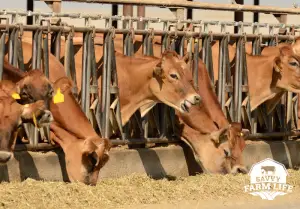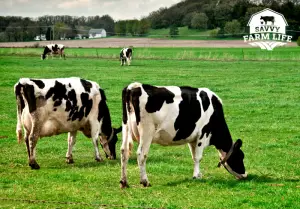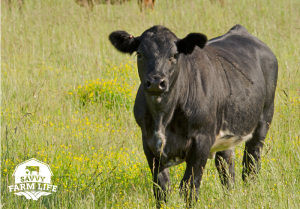How Much It Costs To Butcher A Cow Or Steer
Raising your own beef is a fulfilling process, but also comes with a few logistical challenges. Beef breeds have been designed to put on a large amount of muscle and fat in a short period of time, rewarding their keepers with ample meat at the end of the process. A steer can quickly reach a weight of 1200-1300 pounds, which is more than most small homesteaders can manage when it comes time to slaughter and butcher.
How much does it cost to butcher a cow (or a heifer or a steer)? If you outsource the slaughtering and butchering of your cow, you can expect to pay a $150 slaughtering fee and an additional $1.00-$1.50/pound of hanging weight to cut and wrap the meat for you. For a 1,200-pound steer, this will equal around $1,000 in processing fees. In this scenario, you will be getting around 430 pounds of beef, making the processing fee around $2.32 per pound of final product.
While this may seem like a high number, it is important to keep in mind that we are discussing hundreds of pounds of homegrown beef. There are certainly pros and cons to raising your own beef, but most who live this lifestyle will say the benefits outweigh the disadvantages. Read on to learn about your different options when it comes to processing your own beef, and when it is the best time to slaughter.
Understanding The Expense Of Butchering A Cow Or Steer 
While reading that it can cost $1,000 to butcher a steer may be surprising at first, when put into perspective you will realize that it makes financial sense. Considering a steer can easily weigh 1,200 pounds or more at the time of slaughter, you can see that there is a lot of time, work, and expertise that goes into processing the animals.
You will also need to consider how much product you are getting for that price (again, take into account the cost of raising the animal as well). Beef, like most other grocery products, is becoming more and more expensive by the day. The average American family of four will consume around 230 pounds of beef per year. This means that for an average-sized steer, you can feed your family for a year and offset some of your costs by selling ¼ – ½ a cow to another family.
Of course, most homesteaders do not look at raising their own meat purely from a financial standpoint. While that is a large portion of the consideration, raising your own meat is also an incredibly rewarding and educational experience.
Butchering Your Cow Cost Factors: Live Weight, Hanging Weight, and Processed Weight
If you have looked into raising your own steer or heifer for beef, you have likely run into terms like “hanging weight”, “live weight”, and “processed weight”. What are the differences between these measurements, and how do they affect how the butcher will charge you for processing?
Live weight is just as you would expect – it is the weight of the live, whole animal before slaughter. Most steers are slaughtered for beef when they reach a weight of between 1,000 and 1,500 pounds. This is the animal’s weight when it is most cost-effective to process, giving you ample meat with a high feed conversion rate.
Hanging weight is the weight of the carcass after the slaughter and initial processing, which is the weight of the steer once the head, hide, and some of the organs have been removed. The hanging weight of a steer or heifer is typically 60% of the live weight. Continuing our example of a 1,200-pound steer, we can expect a hanging weight of about 720 pounds.
After this initial processing, there is still a lot left to do before you will have your final product. At this point the butcher will cut and wrap the meat for you. The weight of the finished products you are left with is called the processed weight. The processed weight is typically 60% of the hanging weight. This means that for our 720 pounds of hanging weight, you can expect to receive around 430 pounds of freezer meat.
What Are Your Options When Butchering A Cow? 
You have a few options when it comes to having your animal butchered. You can slaughter and process your steer yourself, you can transport your steer to a local slaughterhouse, or you can outsource the processing to a mobile butcher (also called “ranch butcher” or “farm butcher”). The prices we have outlined above are assuming you use a mobile butcher, but we will discuss the other two options below as well.
Cost of Butchering Your Cow Yourself
Are you someone who likes to DIY? If you have the guts (to handle some guts) and the tools needed for the job, you can process your steer for virtually no added expense. Most small operations do not take this route, but it is a practice as old as time and you can find a number of tutorials online if interested.
To butcher your cow yourself, you will need a means to slaughter quickly and humanely (most commonly a 12-gauge shotgun or a .22 rifle) and the ability to hang the carcass. Most will recommend a winch and a tripod, though it is possible to hang the carcass from a strong tree limb if you have one on the property that can easily support the weight. To skin the animal, you will need nothing more than a sharp knife. And to process, you will need a hack saw (or a clean chain saw if you want to make quick work of it).
Butchering your cow on your own is not for the faint of heart, but it is immensely rewarding if you have the stomach for it and the ability.
Cost of Transporting Your Cow To A Butchering Facility
If you have a truck and a trailer you may be able to save a small amount of money by transporting your steer to a nearby butchering facility yourself. Though the name has negative connotations to it, you are really looking for a local slaughterhouse with this option. You can bring your live steer to a facility, ideally with the ability to finish the processing themselves, and pick up your cut and wrapped beef at a later date. The cutting and wrapping will likely have the same charge as anywhere else, but you may save a bit of money on the slaughtering end.
Cost of Using A Mobile Cow Butcher
Many smaller operations use a mobile (or ranch, or farm) butcher. These butchers do not typically finish the processing on-site, but they will come to your property to slaughter, skin, and start the butchering process. They will usually charge a small fee (of around $25) to dispose of the organs, head, and hide, and will transport the hanging carcass to their own butchering facility, or another butcher of your choosing. They will most often come with a truck with which they can hang the carcass before and as they transport.
Mobile butchers will charge a slaughter fee – usually in the range of $100-$200. One of the benefits of going this route is that you can be with your steer in his last moments, if you so choose. Many homesteaders like the idea of raising their own beef because of their respect for the animal and the ability to ensure that the animal lives as good a life as possible. By having your steer slaughtered on your own property, you are greatly limiting the stress he will experience and ensuring that his “one bad day” really only amounts to one bad moment.
While many of us do not have a problem with the idea of raising our own steer and humanely dispatching at the right time, the reality is that one can easily become quite attached to these large, friendly, docile animals. Cattle are highly social animals, and after a long 18 (or so) months of raising them, you may find yourself having difficulty when it comes time to process.
By outsourcing this task, you can be as involved as you would like, while accepting the assistance of a respectful professional. This can make the job much easier for you, physically and logistically of course, but also emotionally.
When Is The Best Time To Butcher A Cow Or Steer?
Most beef breeds will have reached processing weight between 12 and 22 months of age. By this time, their rate of growth will have begun slowing down, while the meat will still be tender. Most ranchers time their breeding so that calves are born in the late Winter to early Spring, so that they can process in the Fall of the following year.
Processing your calf in the Fall is advantageous for two reasons – you will process before their bodies start converting feed to the energy required to stay warm (thus limiting weight gain), and you will be able to work with the cooler weather to cure the meat if you are processing at home.
If you’re interested in learning more about owning and raising cows, you can read more in my articles below!

